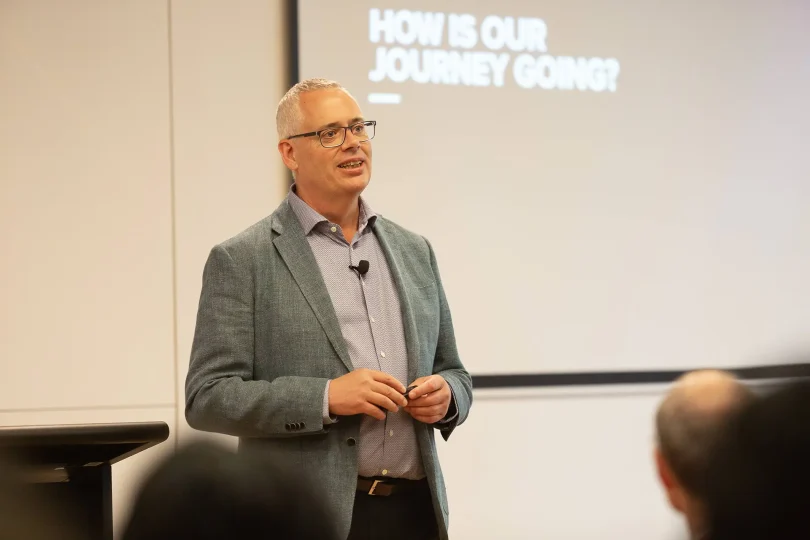Mastering Large-Scale Business Transformation: A Guide to Success in the Public Sector

Large-scale business transformation is no small feat – especially in the public sector. Drawing on insights from seasoned experts, this article explores proven strategies for navigating complexity, balancing innovation with cost, and delivering meaningful outcomes. From aligning with business goals to embracing Agile methodologies, it offers practical guidance for leaders looking to future-proof their transformation efforts and drive sustainable success.
How can organisations balance the need for continuous innovation and delivery with the need to reduce total cost of ownership (TCO) and mitigate project risks? What are some strategies that have worked well to achieve this balance?
1. Understand the business context: It is crucial to clearly understand the organisation’s business goals and objectives. By aligning innovation initiatives with the overall business strategy, decision-makers can prioritise innovation efforts that directly contribute to the organisation’s success.
2. Differentiate between mandatory and discretionary costs: Identifying and categorising costs as mandatory or discretionary help allocate resources efficiently. By focusing on reducing discretionary costs while fulfilling essential obligations, organisations can optimise resource allocation and manage TCO effectively.
3. Prioritise with a backlog and clear process: Creating a backlog of innovation initiatives and establishing a clear prioritisation process ensures that resources are allocated to the most valuable and impactful projects. Prioritisation techniques like Weighted Shortest Job First (WSJF) help minimise project risks and ensure the allocation of resources to high-value projects.
4. Identify and automate repeatable processes: Analysing processes and identifying areas for automation improves efficiency and frees up resources for innovation. Automation reduces manual efforts, minimises errors, and increases productivity, ultimately reducing TCO (Total Cost of Ownership) and enabling organisations to focus on higher-value activities.
5. Embrace Agile methodologies: Agile methodologies, such as Scrum or Kanban, provide a flexible framework for managing innovation, delivery, and risk mitigation. These methodologies promote iterative and incremental development, enabling faster feedback loops and early risk detection while delivering value continuously.
6. Foster a culture of innovation and cost-consciousness: A supportive organisational culture that encourages innovation and cost optimisation is crucial. By promoting a culture that values innovation and cost consciousness, organisations can foster an environment where employees seek innovative solutions mindful of TCO.
Additionally, there are a few additional strategies worth considering:
1. Start with problem identification: Innovation should be driven by specific problem identification. By focusing on innovative solutions that address these problems, organisations can channel their efforts effectively and achieve both innovation and cost savings.
2. Focus on short-term returns: In time-bound projects, emphasising solutions with significant short-term returns helps balance the need for innovation with timely delivery and immediate cost savings.
3. Strong leadership and an “all of life lens”: Strong leadership is essential in guiding investment decisions and project prioritisation. Taking an “all of life lens” approach involves considering the long-term impact of innovation initiatives, ensuring they align with the organisation’s strategic goals.
4. Emphasise high-value automation: Prioritising high-value automation streamlines tasks, reduces manual efforts, and minimises human error. Organisations can leverage automation, particularly in Oracle Cloud implementations, to streamline testing and improve efficiency.
5. Reduce patch upgrade testing: Minimising extensive business testing during patch upgrades through automation and robust testing practices can significantly reduce costs over the system’s lifetime. This approach enables faster and more cost-effective patch upgrades, contributing to TCO reduction and risk mitigation.
By implementing these strategies, organisations can effectively balance continuous innovation and delivery with TCO reduction and project risk mitigation, resulting in successful outcomes.
“Transformation success lies not in doing more, but in doing what matters most –strategically, iteratively, and with purpose”
How can an effective Quality Assurance (QA) strategy promote inclusivity in the development process and reduce the impact of changes on business operations?
Firstly, understanding the business’s pain points is essential. By actively listening to the concerns and challenges faced by the business, we can address their needs and promote inclusivity. This approach helps build trust between the business and the project team, fostering a collaborative environment.
Engaging with all levels of the business is another key aspect. By involving individuals from the shop floor to upper management, we gain diverse perspectives. These insights can uncover potential blind spots and lead to a more comprehensive quality assurance strategy.
Developing clear success criteria in collaboration with the business is vital. Defining what “good enough” looks like enables a shared understanding of expectations. This alignment helps ensure that the quality assurance efforts are focused on delivering a fit-for-purpose solution that meets the business’s requirements.
Shifting Quality Assurance as far left as possible is beneficial. This means involving the business in reviews of the current state and future state business mapping before the development and test execution phases. By incorporating their insights early on, we can concentrate efforts on relevant areas and deliver a solution that aligns with their needs.
Frequent demos and walkthroughs are valuable. Seeking early and continuous feedback from the business as the product is being developed allows for iterative improvements. This involvement also empowers the business to contribute to the solution’s direction and make decisions that support the desired outcomes.
What are the key best practices for delivering new systems, developing and deploying additional functionality, or addressing patches and upgrade cycles that have been shown to save organisations time and money?
Establish clear traceability: Maintaining clear traceability from problem statements to business outcomes, requirements, and tests is essential. This ensures that every step of the process aligns with the overarching business goals, preventing wasted efforts. By establishing a clear traceability path, organisations can easily track progress and validate that desired outcomes are being achieved.
Foster consistent understanding: It is crucial to ensure that all stakeholders, from business leaders to development teams, have a shared understanding of goals, requirements, and tests. This consistency minimises misunderstandings, streamlines decision-making, and enables effective collaboration throughout the project.
Implement a robust change control and prioritisation framework: Having a structured approach to change control and prioritisation allows organisations to assess and prioritise system changes, additional functionality, patches, and upgrades based on their impact and urgency. This ensures that resources are allocated effectively and focuses on the most critical activities.
Maintain good governance: Establishing governance structures that focus on successful project delivery and proactively identify and remove roadblocks is crucial. By ensuring necessary support and resources are available and effectively managing risks, organisations can streamline processes and achieve desired outcomes more efficiently.
Define success and understand risk: Actively engaging business stakeholders ensures that implemented systems and functionalities align with their needs and expectations. Understanding and mitigating risks early on minimises potential impact on the bottom line and increases the likelihood of successful outcomes.
Tailor approach to organisation’s unique needs: Maintaining a clear and unwavering focus on the organisation’s specific requirements and challenges is critical. While utilising proven products or methodologies can be part of the solution, defining success within the organisation’s context allows teams to effectively navigate delivery challenges.
Prioritise based on business impact: Aligning efforts with areas that have the greatest impact on the bottom line is essential. By focusing on delivering functionalities that directly support business objectives and priorities, organisations can optimise resources and maximise return on investment.
Additionally, consider the following practices:
- Ensure business decision-makers are well-informed about problem statements and approved requirements to facilitate informed decisions.
- Involve users early through user acceptance testing (UAT) and change/training sessions to incorporate valuable input and ensure the solution meets their needs.
- Conduct user experience (UX) testing to identify areas for improvement and enhance the overall user experience.
- Promote shared ownership of success among all stakeholders to foster inclusivity and accountability.
- Lower the barrier of entry for business people to facilitate their involvement in the quality assurance process.
- Foster strong relationships within the project/program ecosystem by taking a human-centric approach, involving end-users and subject matter experts upfront, and engaging stakeholders at various levels.
By adopting these best practices, organisations can save time and money in their system delivery, development, and deployment efforts. Clear traceability, consistent understanding, prioritisation frameworks, good governance, business involvement, and a tailored approach all contribute to maximising the impact on the bottom line.
In the context of implementing new systems, what are the most common challenges that organisations face and how can these be mitigated through effective project management and stakeholder management?
Understand your “north star”: Organisations should clearly understand what they are trying to achieve and what success looks like. Defining the desired outcomes and identifying negotiable aspects allows for better decision-making throughout the project. This clarity serves as a guiding principle to keep the project on track.
Ensure clear and appropriate roles and responsibilities: It is crucial to define and allocate decision rights to the right people. Separating governance from management/operational decisions helps streamline the decision-making process. By clarifying roles and responsibilities, organisations can avoid confusion, improve accountability, and facilitate efficient progress.
Determine the balance across the iron triangle: The iron triangle comprises time, budget, and scope. Organisations must have open discussions to determine where contingencies lie. By proactively addressing these discussions during calm periods, everyone involved will be prepared when issues arise. Having a clear understanding of trade-offs helps manage expectations and allows for more effective decision-making during project execution.
Focus on change adoption: The success of the new system depends on users embracing and effectively utilising it. It is essential to involve the business throughout the project journey, ensuring their participation in decision-making processes. Collaboration and co-creation foster a sense of ownership and commitment. Organisations should strive to work “with” the stakeholders rather than imposing changes “to” them. This approach promotes change adoption and increases the chances of successful implementation.
Selecting the right technology: To ensure that the chosen technology solutions meet the business needs, several factors should be considered. Understanding the required outcomes is critical in aligning technology solutions with the desired goals. It is also important to consider any key design principles or enterprise architecture constraints, such as the choice between Software as a Service (SaaS) and On-Premises solutions. Evaluating the total cost of ownership (TCO) and available budget is essential to ensure feasibility. Finally, testing the market through requests for proposal (RFPs), demos, and trials provides valuable insights into the suitability of different technology solutions. Through effective project management and stakeholder engagement, organisations can address the challenges associated with implementing new systems. By focusing on a shared understanding of goals, clear roles, and responsibilities, managing the iron triangle, promoting change adoption, and selecting the right technology solutions, organisations can increase the likelihood of successful implementations that meet their business needs.
What advice would you give to any organisation that’s about to embark on a major transformation programme?
Understand your north star and focus on business engagement and organisational change management: It is essential to have a clear understanding of your organisation’s vision and goals. This “north star” will guide the transformation program and ensure alignment across the organisation. Additionally, effective business engagement and robust change management practices are vital to gain buy-in, manage resistance, and ensure successful adoption of the changes. Celebrating milestones and successes along the way helps to maintain momentum and keep morale high.
Foster a clear and shared understanding of success and risks: Establishing a shared understanding of what success means for the transformation program is essential. Clearly define the desired outcomes, metrics, and key performance indicators. This shared understanding helps align stakeholders and ensures that everyone is working towards the same goals. Additionally, it is crucial to identify and assess potential risks and develop mitigation strategies to proactively address them throughout the program.
Values alignment with partners is key: Transformation programs are often complex and challenging endeavors. Selecting partners who are aligned with your organisation’s values is critical. When faced with difficulties, knowing that your partners share your values ensures that you will work together collaboratively rather than pulling against each other. This alignment fosters a positive and productive working relationship, contributing to the success of the transformation program.
By adhering to this advice, organisations can set themselves up for a successful major transformation program. Understanding the north star, emphasising business engagement and change management, establishing a shared understanding of success and risks, and ensuring values alignment with partners contribute to a more cohesive and effective transformation journey.
Have you experienced any project failure before? If yes, why did the project fail?
When discussing project failure, it is important to define what constitutes failure. Are meeting time, cost, and scope considered a success if the benefits are not fully realised? Additionally, should stopping a project early be considered a failure if the business case is no longer viable or if a fit-for-purpose solution cannot be found through the RFP process?
One example of project failure is the Novopay project. It was a perfect storm of issues resulting from a misalignment of values between the vendor and the organisation. The project involved selecting a product and customising it to meet specific needs. However, what significantly impacted the outcome was the lack of real customer engagement until it reached a point of no return. This experience has had a profound impact on my (Russell Ewart) professional development as an IT professional. It highlighted the critical importance of genuine customer engagement throughout the project lifecycle. Waiting until it’s too late to involve the customer can lead to misaligned expectations, inadequate customisation, and ultimately project failure.
Therefore, to mitigate the risk of project failure, it is crucial to define success beyond meeting time, cost, and scope. Organisations should prioritise the realisation of benefits and regularly assess the alignment of the project with the business case. Moreover, fostering strong values alignment with vendors and engaging customers early on in the project can help avoid pitfalls and ensure that solutions are fit for purpose.
By reevaluating our understanding of project failure and emphasising customer engagement from the outset, organisations can increase the likelihood of project success and achieve desired outcomes.
How do you see the balance of increasingly diverse client complexity, alongside the idea of simplification in pursuit of client experience?
Understand the business outcomes you’re trying to achieve: It is essential to have a clear understanding of the desired business outcomes. This understanding will guide decision-making and ensure that efforts are focused on delivering value to clients.
Understand the culture and makeup of the business: Diverse clients bring unique cultures, preferences, and needs. It is crucial to take the time to understand the specific characteristics of each client and tailor the approach accordingly. By doing so, organisations can provide a more personalised and relevant client experience.
Understand the feasibility of any proposed delivery approach: While pursuing simplification, it is important to assess the feasibility of the chosen delivery approach. Evaluate whether the proposed solution aligns with the complexity and diversity of client needs. Finding the right balance between simplification and customisation ensures that clients’ unique requirements are met effectively.
Be prepared to have tough conversations: Managing diverse client complexity may require difficult conversations to address conflicting priorities or challenges. It is essential to foster open and transparent communication with clients, allowing for constructive dialogue and problem-solving.
Trust the intellectual property (IP) that has been acquired to enable delivery: Organisations often invest in tools, technologies, and frameworks to streamline and simplify client experiences. Trust the acquired IP and leverage it appropriately to enhance the client experience while managing complexity.
Reflect on prior experience and lessons learned: Take the opportunity to learn from previous experiences and apply those insights to the current situation. Reflecting on lessons learned enables continuous improvement and the refinement of strategies for balancing complexity and simplification in the pursuit of an optimal client experience.
By considering these points, organisations can navigate the delicate balance between increasing client complexity and simplification. Understanding business outcomes, cultural nuances, feasibility, and being prepared for challenging conversations while leveraging acquired IP and drawing from past experiences will help organisations provide a tailored and enhanced client experience while effectively managing complexity.
Click here to download the guide ‘Develop a Winning Strategy – Mastering Large-Scale Business Transformation: A Guide to Success in the Public Sector.’
“Agility isn’t just a methodology – it’s a mindset that empowers teams to adapt, deliver, and thrive in complexity.”
Conclusion: Strategy, Agility, and Impact
Mastering large-scale business transformation requires more than just ambition – it demands clarity, adaptability, and a deep understanding of organisational context. By prioritising initiatives that align with strategic goals, embracing Agile practices, and fostering a culture of innovation and cost-consciousness, organisations can reduce risk while delivering continuous value. The insights shared by Assurity’s expert panel serve as a valuable guide for leaders committed to driving impactful, future-ready transformation programmes.


